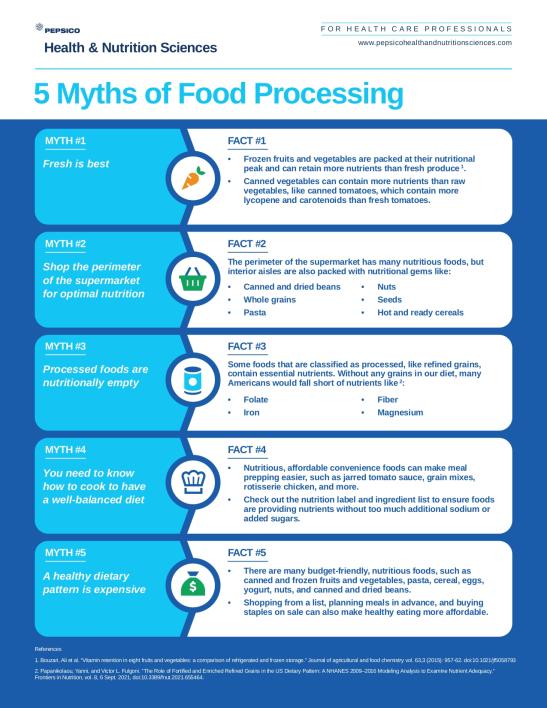5 Myths of Food Processing
Description: There are many myths about processed foods and the benefits and challenges of food processing. This handout explores 5 common myths of food processing and the ways that certain processed foods can help Americans meet dietary guidelines.
5 Myths of Food Processing
Myth #1: Fresh is best
Fact: Frozen fruits and vegetables are packed at their nutritional peak and can retain more nutrients than fresh produce. Canned vegetables can contain more nutrients than raw vegetables, like canned tomatoes, which contain more lycopene and carotenoids than fresh tomatoes1.
Myth #2: Shop the perimeter of the supermarket for optimal nutrition
Fact: The perimeter of the supermarket has many nutritious foods, but interior aisles are also packed with nutritional gems like:
- Canned and dried beans
- Whole grains
- Pasta
- Nuts
- Seeds
- Hot and ready cereals
Myth #3: Processed foods are nutritionally empty
Fact: Some foods that are classified as processed, like refined grains, contain essential nutrients. Without any grains in our diet, many Americans would fall short of nutrients like:
- Folate
- Iron
- Fiber
- Magnesium 2
Myth #4: You need to know how to cook to have a well-balanced diet
Fact: Nutritious, affordable convenience foods can make meal prepping easier, such as jarred tomato sauce, grain mixes, rotisserie chicken, and more. Check out the nutrition label and ingredient list to ensure foods are providing nutrients without too much additional sodium or added sugars.
Myth #5: A healthy dietary pattern is expensive
Fact: There are many budget-friendly, nutritious foods, such as canned and frozen fruits and vegetables, pasta, cereal, eggs, yoghurt, nuts, and canned and dried beans. Shopping from a list, planning meals in advance, and buying staples on sale can also make healthy eating more affordable.
Click the link to the right to download the handout to use with your patients and clients!
References
Bouzari, Ali et al. “Vitamin retention in eight fruits and vegetables: a comparison of refrigerated and frozen storage.” Journal of agricultural and food chemistry vol. 63,3 (2015): 957-62. doi:10.1021/jf5058793
Papanikolaou, Yanni, and Victor L. Fulgoni. “The Role of Fortified and Enriched Refined Grains in the US Dietary Pattern: A NHANES 2009–2016 Modeling Analysis to Examine Nutrient Adequacy.” Frontiers in Nutrition, vol. 8, 6 Sept. 2021, doi:10.3389/fnut.2021.655464.
- Food processing myths and facts
